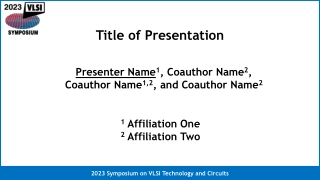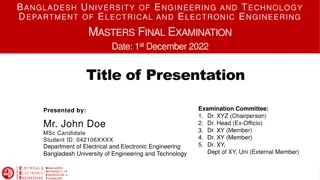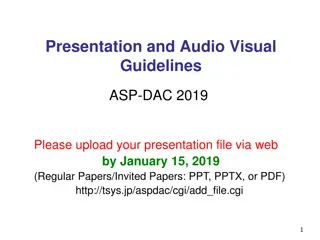Computer Architecture Simulators for Different Instruction Formats
Development of computer simulators to address limitations in the MARIE machine simulator, enabling comparison of various computer architectures through the implementation of different instruction formats. The simulators allow for programming diverse computer processors using assembly languages, with enhancements such as additional instructions, debugging functions, user interfaces, and support for microarchitectures. Examples include stack-based, accumulator-based, and two-address machines for executing assembly language programs to perform tasks like computing sums of absolute values and generating Fibonacci numbers.
Download Presentation

Please find below an Image/Link to download the presentation.
The content on the website is provided AS IS for your information and personal use only. It may not be sold, licensed, or shared on other websites without obtaining consent from the author.If you encounter any issues during the download, it is possible that the publisher has removed the file from their server.
You are allowed to download the files provided on this website for personal or commercial use, subject to the condition that they are used lawfully. All files are the property of their respective owners.
The content on the website is provided AS IS for your information and personal use only. It may not be sold, licensed, or shared on other websites without obtaining consent from the author.
E N D
Presentation Transcript
Computer Architecture Simulators for Different Instruction Formats Xuejun Liang Department of Computer Science California State University Stanislaus Turlock, CA 95382, USA
Motivation MARIE is an accumulator-based machine simulator Used in The Essentials of Computer Organization and Architecture, by Linda Null and Julia Lobur for assembly language programming But, MARIE simulator has some problems: Programmers can not define a variable to hold the address of another variable symbolically. Conditional branch can only skip the next instruction. It takes numbers as its operands for indicating different conditions. Programmers have to remember these numbers. MARIE do not have the stack pointer. So there is no stack frame and its subroutine has no local variables and can not be recursive. How to solve these problems? Fix it or create a new one.
Purpose To solve these problems, and furthermore, to be able to compare different computer architectures, a set of computer simulators for different instruction formats are developed. Using these simulators Program different computer processors using assembly languages. Modifying these simulators Add more instructions Add more debugging functions Add user interfaces Design microarchitectures to support the execution of instructions of simulated machines Serving as compiler s target computers
Outlines Simulated Instruction Sets Stack-based (Zero address) Machine Accumulator-based (one address) Machine Two address Machine Memory-to-Memory and Register-to-Register Three address Machine Memory-to-Memory and Register-to-Register Assembly Language Programming Examples Compute sum of absolute values of elements in an array Compute Fibonacci numbers Using loop, function, and recursive function
Two-address machine (M-to-M) Binary, two's complement data representation. Stored program, fixed word length data and instructions. 64K words of word-addressable data memory. 64K double words of word-addressable instruction memory. 32-bit data words. 64-bit instructions. A 32-bit arithmetic logic unit (ALU). Only arithmetic operations are implemented Registers PC: 32-bit Program counter SP: Stack pointer pointing to the top of the stack
Implementations (1) Two separate 32-bit integer arrays are used for memory data, and input data, respectively. One 64-bit integer arrays are used for instructions. But, Each instruction takes only 39 bits 5-bit opcode, and two 16-bit operand (address). Two 1-bit indicating if the operand is local or global. Instruction memory address is 16 bits. So, Instructions will take up to 64K 64-bit words (or integers). The branch instructions use 16-bit absolute address. The instructions JNS also uses 16-bit absolution address Each datum occupies 32 bits. The data address is 16 bits. So, we have 64K words of data memory. Stack is growing towards higher data memory address
Instruction Set Two M2M op 0 1 2 3 4 5 6 7 8 9 10 11 12 13 14 15 16 17 18 Instruction LI C Imm ADDI Imm ADD C A SUB C A MUL C A DIV C A REM C A GET C A PUT C A GOTO L BEQZ A L BNEZ A L BGEZ A L BLTZ A L JNS L JR READ PRNT STOP Meaning M[C] Imm M[C] M[C]+Imm M[C] M[C]+M[A] M[C] M[C]-M[A] M[C] M[C]*M[B] M[C] M[C]/M[B] M[C] M[C]%M[B] M[C] M[M[A]] M[M[A]] M[C] PC L If M[A] = 0 GOTO L If M[A] 0 GOTO L If M[?] 0 GOTO L If M[A] < 0 GOTO L PUSH PC & PC L PC M[M[SP]] & POP M[INPUT] input Print M[OUTPUT] Terminate program Imm: PC: M[A]: PUSH PC: Push PC on stack POP: Remove top content on stack SP: Reserved location, Stack pointer ZERO: Reserved location, M[ZERO]=0 INPUT: Reserved location for input OUTPUT: Reserved location for output 16-bit 2 s compliment Program counter Memory content of variable A $+Imm: Local variable Its address is M[SP]+Imm, where Imm is a 16-bit integer. Example: ADD Var $+4 means M[Var] = M[Var] + M[M[SP]+4]
Pseudo-Instructions Pseudo- instruction MOVE A B Meaning Instruction M[A] M[B] 1 ADD ZERO B LI A 0 ADD A ZERO LI ZERO 0 SUB ZERO A LI A 0 ADD A ZERO LI ZERO 0 GET A SP ADDI SP -1 ADDI SP 1 PUT A SP M[A] -M[A] 2 NEG A M[A] M[M[SP]] M[SP] M[SP] 1 M[SP] M[SP] + 1 M[M[SP]] M[A] 3 POP A 4 PUSH A
Three-address machine (M-to-M) Binary, two's complement data representation. Stored program, fixed word length data and instructions. 64K words of word-addressable data memory. 64K double words of word-addressable instruction memory. 32-bit data words. 64-bit instructions. A 32-bit arithmetic logic unit (ALU). Only arithmetic operations are implemented Registers PC: 32-bit Program counter SP: Stack pointer pointing to the top of the stack
Implementations (1) Two separate 32-bit integer arrays are used for memory data, and input data, respectively. One 64-bit integer arrays are used for instructions. But, Each instruction takes only 56 bits 5-bit opcode, and three 16-bit operand (address). Three 1-bit indicating if the operand is local or global. Instruction memory address is 16 bits. So, Instructions will take up to 64K 64-bit words (or integers). The branch instructions use 16-bit absolute address. The instructions JNS also uses 16-bit absolution address Each datum occupies 32 bits. The data address is 16 bits. So, we have 64K words of data memory. Stack is growing towards higher data memory address
Instruction Set Three M2M op 0 1 2 3 4 5 6 7 8 9 10 11 12 13 14 15 16 17 18 Instruction LI C Imm ADDI C A Imm ADD C A B SUB C A B MUL C A B DIV C A B REM C A B GET C A B PUT C A B GOTO L BEQ A B L BNE A B L BGE A B L BLT A B L JNS L JR READ PRNT STOP Meaning M[C] Imm M[C] M[A]+Imm M[C] M[A]+M[B] M[C] M[A]-M[B] M[C] M[A]*M[B] M[C] M[A]/M[B] M[C] M[A]%M[B] M[C] M[A+M[B]] M[A+M[B]] M[C] PC L If M[A] = M[B] GOTO L If M[A] M[B] TO L If M[A] M[B] GOTO L If M[A] < M[B] GOTO L PUSH PC & PC L PC M[M[SP]] & POP M[INPUT] Input Print M[OUTPUT] Stop Imm: PC: M[A]: PUSH PC: Push PC on stack POP: Remove top content on stack SP: Reserved location, Stack pointer ZERO: Reserved location, M[ZERO]=0 INPUT: Reserved location for input OUTPUT: Reserved location for output 32-bit 2 s compliment Program counter Memory content of variable A $+Imm: Local variable Its address is M[SP]+Imm, where Imm is a 16-bit integer. Example: ADD A B $+4 means M[A] = M[B] + M[M[SP]+4]
Pseudo-Instructions Pseudo- instruction MOVE A B GETI A B PUTI A B BEQZ A L BNEZ A L BGEZ A L BLTZ A L NEG A POP A Meaning Instruction M[A] M[B] M[A] M[M[B]] M[M[B]] M[A] If M[A] = 0 GOTO L If M[A] 0 GOTO L If M[?] 0 GOTO L If M[A] < 0 GOTO L M[A] - M[A] M[A] M[M[SP]] M[SP] M[SP] 1 M[SP] M[SP] + 1 M[M[SP]] M[A] 1 2 3 4 5 6 7 8 9 ADD A ZERO B GET A ZERO B PUT A ZERO B BEQ A ZERO L BNE A ZERO L BGE A ZERO L BLT A ZERO L SUB A ZERO A GET A ZERO SP ADDI SP SP -1 ADDI SP SP 1 PUT A ZERO SP 11 PUSH A
Two-address machine (R-to-R) Binary, two's complement data representation. Stored program, fixed word length data and instructions. 64K words of word-addressable data memory. 64K words of word-addressable instruction memory. 32-bit data words. 32-bit instructions. A 32-bit arithmetic logic unit (ALU). Only arithmetic operations are implemented Registers PC: 32-bit Program counter SP: Stack pointer pointing to the top of the stack
32 General-Purpose Registers MIPS Register Convention Name $zero $at $v0-$v1 $a0-$a3 $t0-$t7 $s0-$s7 $t8-$t9 $k0-$k1 $gp $sp $fp $ra Number $0 $1 $2-$3 $4-$7 $8-$15 $16-$23 $24-$25 $26-$27 $28 $29 $30 $31 Usage The constant value 0 Reserved for assembler Expression evaluation and results of a function Argument 1-4 Temporary (not preserved across call) Saved temporary (preserved across call) Temporary (not preserved across call) Reserved for OS kernel Pointer to global area Stack pointer Frame pointer Return address (used by function call)
Implementations (R2R) Three separate 32-bit integer arrays are used for instructions, memory data, and input data, respectively. But, Each instruction takes only 26 bits 5-bit opcode, 5-bit registers, and 16-bit operand (address). Instruction memory address is 16 bits. So, Instructions will take up to 64K 32-bit words (or integers). The branch instructions use 16-bit absolute address. The instructions JNS also uses 16-bit absolution address Each datum occupies 32 bits. The data address is 16 bits. So, we have 64K words of data memory. Stack is growing towards higher data memory address
Instruction Set Two R2R op 0 1 2 3 4 5 6 7 8 9 10 11 12 13 14 15 16 17 18 Instruction LI R Imm R Imm ADDI R Imm R R+Imm ADD R R1 SUB R R1 MUL R R1 DIV R R1 REM R R1 GET R R1 PUT R R1 GOTO L BEQZ R L BNEZ R L BGEZ R L BLTZ R L JNS L JR READ PRNT STOP Meaning R R+R1 R R-/R1 R R*R1 R R/R1 R R%R1 R M[R1] M[R1] R PC L If R = 0 GOTO L If R 0 GOTO L If R 0 GOTO L If R < 0 GOTO L $ra PC & PC L PC $ra $v0 Input Print $a0 Stop Imm: PC: R, R1: L: M[R]: 16-bit 2 s compliment Program counter Registers Label Memory content at address R
Pseudo-Instructions Pseudo-instruction 1 LA R Var 2 MOVE R R1 Meaning R &Var R R1 Instruction LI R Var LI $at 0 ADD $at R1 LI R 0 ADD R $at LI $at 0 SUB $at R LI R 0 ADD R $at LI $at Imm GET R2 $at LI $at Imm PUT R2 $at LI $at var GET R2 $at LI $at var PUT R2 $at GET R $sp ADDI $sp -1 ADDI $sp 1 PUT R $sp R -R 3 NEG R R2 M[Imm] 4 GETI R2 Imm M[Imm] R2 5 PUTI R2 Imm R2 M[Var] 6 GETV R2 Var M[Var] R2 7 PUTV R2 Var R M[$sp] $sp = $sp - 1 $sp = $sp + 1 M[$sp] R 8 POP R 9 PUSH R
Three-address machine (R2R16) Binary, two's complement data representation. Stored program, fixed word length data and instructions. 64K words of word-addressable data memory. 64K words of word-addressable instruction memory. 32-bit data words. 32-bit instructions. A 32-bit arithmetic logic unit (ALU). Only arithmetic operations are implemented Registers PC: 32-bit Program counter SP: Stack pointer pointing to the top of the stack
Implementations (R2R16) Three separate 32-bit integer arrays are used for instructions, memory data, and input data, respectively. But, Each instruction takes at most 31 bits 5-bit opcode, two 5-bit registers, and 16-bit operand (address). Instruction memory address is 16 bits. So, Instructions will take up to 64K 32-bit words (or integers). The branch instructions use 16-bit absolute address. The instructions JNS also uses 16-bit absolution address Each datum occupies 32 bits. The data address is 16 bits. So, we have 64K words of data memory. Stack is growing towards higher data memory address
Instruction Set Three R2R op Instruction 0 LI R Imm 1 ADDI R R1 Imm 2 ADD R R1 R2 3 SUB R R1 R2 4 MUL R R1 R2 5 DIV R R1 R2 6 REM R R1 R2 7 GET R R1 offset 8 PUT R R1 offset 9 GOTO L 10 BEQ R R1 L 11 BNE R R1 L 12 BGE R R1 L 13 BLT R R1 L 14 JNS L 15 JR 16 READ 17 PRNT 18 STOP Meaning R Imm R R1+Imm R R1 + R2 R R1 + R2 R R1 + R2 R R1 + R2 R R1 + R2 R M[R1+ offset] M[R1+ offset] R PC L If R = R1 GOTO L If R R1 GOTO L If R R1 GOTO L If R < R1 GOTO L $ra PC & PC L PC $ra $v0 Input Print $a0 Terminate Imm: offset: PC: R, R1: L: M[R]: 16-bit 2 s compliment Imm or address of variable Program counter Registers Label Memory content at address R
Pseudo-Instructions 3A R2R Pseudo-instruction Meaning LA R Var MOVE R2 R1 NEG R GETR R2 R1 PUTR R2 R1 GETI R2 imm PUTI R2 imm GETV R2 Var PUTV R2 Var BEQZ R L BNEZ R L BGEZ R L BLTZ R L POP R Instruction Var: variable, 16-bit address ADD R2 R1 $zero SUB R $zero R GET R2 R1 0 PUT R2 R1 0 GET R2 $zero imm PUT R2 $zero imm GET R2 $zero var PUT R2 $zero var BEQ R $zero L BNE R $zero L BGE R $zero L BLT R $zero L GET R $sp 0 ADDI $sp $sp -1 ADDI $sp %sp 1 PUT R $sp 0 R &Var R2 R1 R - R R2 M[R1] M[R1] R2 R2 M[imm] M[imm] R2 R2 M[Var] M[Var] R2 If R = 0 GOTO L If R 0 GOTO L If R 0 GOTO L If R < 0 GOTO L R M[SP] SP SP 1 SP SP + 1 M[SP] R 0 1 2 3 4 5 6 7 8 9 10 11 12 13 14 PUSH R
Program Structure and Syntax (1) Every program contains three sections and separated by END Data (optional) Code Input (optional) Data (Declarations) One variable definition per line ID (identifier) is the variable name. Type is a positive integer Type = 1, ID is a scalar variable Type > 1, ID is an array variable Value is up to Type initial integers of ID. If less than Type initial values are provided, default initial values are used. [Data] END Code END [Input] ID Type [Value] [Label:] Instruction Number (integer)
Program Structure and Syntax (2) Code (Instructions) One instruction per line Labelis optional. It must be followed by : immediately. There is no space between Label and : . Instruction is any instruction, including pseudo-instruction. Input: One input value per line. Number is any integer. Comments: Any text starting from // to the end of the line will be considered as comments [Data] END Code END [Input] ID Type [Value] [Label:] Instruction Number (integer)
Example 1: Compute sum of absolute values of elements in an array C++ code int main() { int DAT [ 9] = {10, 20, 30, -40, 50, 60, 70, 80, -90} //array int N = 9; //number of elements in array int SUM = 0; //sum int I; for (I = 0; I < N; I++) if (DAT < 0) DAT[I] = - DAT[I]; SUM = SUM + DAT[I]; std::cout << SUM; return 0; }
Example 1: Two-Address M2M Code 1/2 //Declaration PDAT SUM NUM TMP DAT END 1 1 1 1 9 DAT 0 9 0 10 20 30 -40 50 60 70 80 -90 //Array of integers //Pointer to the array DAT //Sum //Number of elements in the array //Temporary location
Two-Address M2M Code //Instructions L1: BEQZ GET BGEZ NEG L2: ADD ADDI ADDI GOTO L3: MOVE PRNT STOP END //Inputs //None NUM TMP TMP TMP SUM REM PDAT L1 OUTPUT SUM L3 PDAT L2 TMP -1 1 //If NUM=0, done //Get an element from array //if positive, skip //TMP = -TMP //Add to sum //Decrease NUM by one //Point to next array element //Next iteration //Print sum on screen //Terminate program
Example 1: Two-Address R2R Code 1/2 //Declaration SUM NUM SUM DAT END 1 1 1 9 0 9 0 10 20 30 -40 50 60 70 80 -90 //Sum //Number of elements in the array //Sum //Array of integers
Two-Address R2R Code //Instructions LA GET LA LI L1: BEQZ GET BGEZ NEG L2: ADD ADDI ADDI GOTO L3: LA PUT PRNT STOP END //Input //None $s0 NUM $t0 $s0 $s0 DAT $a0 0 $t0 L3 $t1 $s0 $t1 L2 $t1 $a0 $t1 $t0 -1 $s0 1 L1 $s0 SUM $a0 $s0 //$s0 = address of NUM //$t0 = NUM //$s0 = address of DAT //$a0(sum) = 0 //If no remaining element, done //Get an array element into $t1 //If positive, skip //Else, negate $t1 //Add to $a0(sum) //Decrease number of remaining elements //Next element //Next iteration //$s0 = address of SUM //Save the sum to SUM //Print sum on screen //Terminate program
Example 1: Three-Address M2M Code 1/2 //Declaration SUM NUM TMP IND DAT END 1 1 1 1 9 0 9 0 0 10 20 30 -40 50 60 70 80 -90 //Array of integers //Sum //Number of elements in the array //Temporary location //Array Index
Three-Address M2M Code 2/2 //Instructions L1: BEQ GET BGE NEG L2: ADD ADDI GOTO L3: MOVE PRNT STOP END //Inputs //None IND NUM L3 TMP DAT IND TMP ZERO L2 TMP SUM SUM TMP IND IND 1 L1 OUTPUT SUM //If IND=NUM, done //Get an array element into TMP //If positive, skip //Else, negate //Add to sum //Increase index IND by one //Next iteration //Move sum into OUTPUT //Print sum on screen //Terminate program
Example 1: Three-Address R2R Code 1/2 //Declaration SUM NUM DAT END 1 1 9 0 9 10 20 30 -40 50 60 70 80 -90 //Sum //Number of elements in the array //Array of integers
Three-Address R2R Code 2/2 //Instructions LI GET LI L1: BEQ GET BGEZ NEG L2: ADD ADDI GOTO L3: PUT PRNT STOP END //Input //None $t0 0 $t1 $zero NUM $a0 0 $t0 $t1 L3 $t2 $t0 DAT $t2 L2 $t2 $a0 $a0 $t2 $t0 $t0 1 L1 $a0 $zero SUM //$t0(index) = 0 //$t1 = NUM //$a0(sum)=0 //If index=NUM, done //Get an array element in $t2 //If positive, skip //Else, negate //Add $t2 to $a0(sum) //Increase index //Next iteration //Save the sum to SUM //Print sum on screen //Terminate program
Example 1: Compute sum of absolute values of elements in an array: Comparison (1) Comparison (1) Loop control Array access 2A M2M Using the length of the array to control the loop. In each loop iteration, the length is deceased by one. When the length becomes zero, the loop ends. Using a pointer to access array element. In each loop iteration, move the pointer to point to next array element. 2A R2R 3A M2M Using the array index to control the loop. In each loop iteration, the index is increased by one. When the index becomes to equal the array length, then loop end. Using array index to access the array elements using the array base address plus the index. In each loop iteration, the index is increased by one . 3A R2R
Example 1: Compute sum of absolute values of elements in an array: Comparison (2) Comparison (2) NI LI PS NIMA NDMA TNMA 2A M2M 17 39 bits 663 bits 106 (11N+7) 190 (20N+10) 296 2A R2R 19 26 bits 494 bits 108 (11N+9) 11 (1N+2) 119 208 3A M2M 10 56 bits 560 bits 67 (7N+4) 141 (15N+6) 3A R2R 13 31 bits 403 bits 70 (7N+7) 11 (1N+2) 81 NI LI PS NIMA NDMA TNMA Total number of memory accesses during execution Number of instructions Length of instruction Program size Number of instructions fetched from memory during execution Number of data memory accesses during execution
Example 2: Compute Fibonacci Number fib(N), Where N is an Input ??? ? = ? ?? ? < 2 ?? ? 2 Mathematics formula ? ? 1 + ?(? 2 int I, A, B, C, N std::cin >> N; if (N < 2) C = N; else { A = 0; B = 1; for (I = 2; I <= N; I++) { C = B + A; A = B; B = C; } } std::cout << C; C++ code using a loop
Example 2: Loop Solution //Instruction READ MOVE MOVE ADDI BLTZ L1: MOVE ADD MOVE MOVE ADDI BGEZ L2: MOVE PRNT STOP END 10 N INPUT //N = Input C N //C=N N -2 //N = N-2 N L2 //If N<2, done C B //C = B C A //C = C + A A B //A = B B C //B = C N -1 //N-- N L1 //If N >=0 OUTPUT C //Print C //Terminate //Input Two Address M2M Code //Declarations N 1 0 C 1 0 B 1 1 A 1 0 END //N //f(N) //f(N-1) //f(N-2)
Example 2: Loop Solution //Instruction READ MOVE MOVE ADDI BLT L1: ADD MOVE MOVE ADDI BGE L2: MOVE PRNT STOP END 10 N INPUT C N N N -2 N ZERO L2 C B A A B B C N N -1 N ZERO L1 OUTPUT C //Input //N = Input //C = N //N = N-2 //If N<2, done //C = B + A //A = B //B = C //N-- //if N >=0 continue //OUTPUT = C //Print OUTPUT //Terminate Three Address M2M Code //Declarations N 1 0 C 1 0 B 1 1 A 1 0 END //N //f(N) //f(N-1) //f(N-2)
Example 2: Loop Solution END READ MOVE ADDI BLTZ LI LI $a0 $v0 $v0 -2 $v0 L2 $t1 0 $t2 1 $a0 $t2 $a0 $t1 $t1 $t2 $t2 $a0 $v0 -1 $v0 L1 //$v0 = N //$a0(C) = N //$v0 = $v0-2 //If N<2, done //$t1(A) = 0 //$t2(B) = 1 //$t3(C) = B, //C = B+A //A = B //B = C //N-- //if N >= 0, continue //Print result ($a0 ) //Terminate Two Address R2R Code Register assignment $v0: N, $t1: A, $t2: B, $a0: C (f(N)) L1: MOVE ADD MOVE MOVE ADDI BGEZ L2: PRNT STOP END 10
Example 2: Loop Solution END READ MOVE ADDI BLT LI LI $a0 $v0 $v0 $v0 -2 $v0 $zero L2 //If N<2, done $t1 0 $t2 1 $a0 $t1 $t2 $t1 $t2 $t2 $a0 $v0 $v0 -1 $v0 $zero L1 //if N >= 0, continue //Print result ($a0) //Terminate //$v0 = N //$a0(C) = N //$v0 = $v0-2 Three Address R2R Code //$t1(A) = 0 //$t2(B) = 1 //C = A+B //A = B //B = C //N-- Register assignment $v0: N, $t1: A, $t2: B, $a0: C (f(N)) L1: ADD MOVE MOVE ADDI BGE L2: PRNT STOP END 10
Example 2: Compute Fibonacci using a loop: Comparison (1) 3-Address 2-Address C = A + B A = B B = C C = B C = C + A A = B B = C
Example 2: Compute Fibonacci using a loop: Comparison (2) Branch and Loop control 2A M2M If N-2 < 0, then f(N) = N, else use a loop to compute f(N). Using N-2 to control the loop. In each loop iteration, N-2 is deceased by one. When it is greater or equal to zero, the loop continues. 2A R2R 3A M2M 3A R2R
Example 2: Compute Fibonacci using a loop: Comparison (3) NI LI PS NIMA NDMA TNMA 32 39 bits 1,248 26 bits 676 56 bits 728 31 bits 403 152 (15(N-1)+17) 299 (30(N-1)+29) 451 2A M2M 26 146 (15(N-1)+11) 0 146 2A R2R 13 53 (5(N-1)+8) 132 (13(N-1)+15) 185 3A M2M 13 53 (5(N-1)+8) 0 53 3A R2R NI LI PS NIMA NDMA TNMA Total number of memory accesses during execution Number of instructions Length of instruction Program size Number of instructions fetched from memory during execution Number of data memory accesses during execution
Example 2: C++ Code Using Function int N; int N; int fib(int N) { int I, A, B, C; if (N < 2) return N; else { A = 0; B = 1; for (I = 2; I <= N; I++) { C = B + A; A = B; B = C; } } return C; } int fib(int N) { if (N < 2) return N; else return f(N-1)+f(N-2); } cin >> N; C = fib(N); cout << C; Recursive function cin >> N; C = fib(N); cout << C; Non-recursive function
Example 2: Using Function (Simplified) Activation Record Two Address M2M Code 1/2 END Addr Name Explanation READ PUSH JNS POP PRNT STOP $-1 N/Fib(N)/C Input/output INPUT Fib OUTPUT $ RA Return Address //call Fib $+1 A Local variable $+2 B Local variable $+3 SN Local variable
Two Address M2M Code 2/2 Fib: MOVE ADDI BLTZ LI LI L1: MOVE ADD MOVE MOVE ADDI BGEZ L2: JR END 10 $+3 $-1 $+3 -2 $+3 L2 $+1 0 $+2 1 $-1 $+2 $-1 $+1 $+1 $+2 $+2 $-1 $+3 -1 $+3 L1 //SN = N //SN = SN-2 //if SN < 0, done //A = 0 //B = 1 //C = B //C = C + A //A = B //B = C //SN = SN-1 //If SN >= 0, continue
Example 2: Using Function Activation Record Three Address M2M Code 1/2 END Addr Name Explanation READ PUSH JNS POP PRNT STOP $-1 N/Fib(N)/C Input/output INPUT Fib OUTPUT $ RA Return Address //call Fib $+1 A Local variable $+2 B Local variable $+3 SN Local variable
Three Address M2M Code 2/2 Fib: ADDI BLTZ LI LI L1: ADD MOVE MOVE ADDI BGEZ L2: JR END 10 $+3 $-1 -2 $+3 L2 $+1 0 $+2 1 $-1 $+1 $+2 //C = A+B $+1 $+2 $+2 $-1 $+3 $+3 -1 $+3 L1 //SN = N-2 //if SN < 0, done //A = 0 //B = 1 //A = B //B = C //SN = SN-1 //If SN >= 0, continue
No Example 2: Using Function Activation Record Is needed //compute f(N) Fib: MOVE ADDI BLTZ LI LI L1: MOVE ADD MOVE MOVE ADDI BGEZ L2: JR END 10 Two Address R2R Code $v0 $a0 $a0 -2 $a0 L2 $t1 0 $t2 1 $v0 $t2 $v0 $t1 $t1 $t2 $t2 $v0 $a0 -1 $a0 L1 //$v0(C) = $a0(N) //N = N-2 //If N<2, done //$t1(A) = 0 //$t2(B) = 1 //C = B //C = C+A //A = B //B = C //N = N-1 //Declarations //None END //Instructions READ MOVE $a0 $v0 JNS Fib MOVE $a0 $v0 PRNT STOP //$v0 = N //$a0 = $v0 //$v0 = Fib(N) //$a0=$v0 //Print $a0 Register assignment $a0: input to function: N $v0: output from function: C $t1: A, $t2: B
Example 2: Using Function No Activation Record Is needed //compute f(N) Fib: MOVE ADDI BLTZ LI LI L1: ADD MOVE MOVE ADDI BGEZ L2: JR END 10 Three Address R2R Code $v0 $a0 $a0 $a0 -2 $a0 L2 $t1 0 $t2 1 $v0 $t1 $t2 //C = A+B $t1 $t2 $t2 $v0 $a0 $a0 -1 $a0 L1 //$v0(C) = $a0(N) //N = N-2 //If N<2, done //$t1(A) = 0 //$t2(B) = 1 //Declarations //None END //Instructions READ MOVE $a0 $v0 JNS Fib MOVE $a0 $v0 PRNT STOP //$v0 = N //$a0 = $v0 //$v0 = Fib(N) //$a0=$v0 //Print $a0 //A = B //B = C //N = N-1 Register assignment $a0: input to function: N $v0: output from function: C $t1: A, $t2: B
Example 2: Compute Fibonacci using a function: Comparison (1) Stack Frames and parameter passing 2A M2M 1 input/output, 1 return address, 3 local variables, accessed via $ 3A M2M Same as 2A M2M 2A R2R No stack frame used. Using registers to pass input/output, use registers for local variables 3A R2R Same as 2A R2R Parameter passing and local variables for architecture with in general-purpose registers can utilize these registers. Otherwise, stack is usually required.























